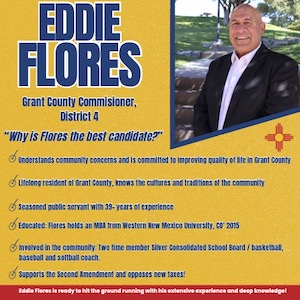Tiffany Kanuf, Grant County Community Health Council coordinator, and Priscilla Lucero, GCCHC chairwoman, presented their successes and concerns to Rep. Rodolopho "Rudy" Martinez, Rep. Dianne Hamilton and Sen. Howie Morales at the Legislative Forum, hosted by Prospectors.
"We have 30 members, who are community leaders from different sectors in the community," Knauf said. "We meet quarterly and are appointed by the county. We do community assessments and create a plan and profile."
In 2007, GCCHC had five priorities, which will be revisited in 2012. The priorities include behavioral health, community safety, economic development, family resiliency and fitness and nutrition. The priorities are used by Freeport McMoRan Copper & Gold Inc.'s-funded Community Investment Fund as criteria for all grant proposals.
She presented a history of the health council from the time it was started in 1991 as the Maternal and Child Health Council for Grant and Hidalgo counties. In 1999, it became the Grant County Community Health Council, funded by the New Mexico Department of Health. In 2010, all funding from DOH was cut, but the council continues to exist on non-encumbered funding. In 2012, Gila Regional Medical Center committed to maintaining health council funding, and Grant County provides office space and support.
‘This is not the case for over 75 percent of the other counties across the state," Knauf said. "We really need the support of DOH to keep everyone functional through the coming year. As of June 2012, many other health councils in the state will cease operation."
Based on the results of the 2007 Community Assessment, which tallied 3,000 respondents 10 percent of the county's population several main issues were identified.
In economic development, a need exists for vocational training, workforce development and work ethics training.
In access to health services, a need for substance/alcohol abuse treatment, elderly day care/respite and cancer treatments and information were identified. The GRMC Cancer Center and a health council DOH cancer support grant help with these efforts.
Concerns about substance/alcohol abuse, domestic violence, teen pregnancy and a lack of youth activities were identified under community and social health.
Environmental health concerns include road conditions, fire danger and land management.
On overall quality of life in Grant County, 80 percent responded that it was "good" or higher.
"One of our most popular events is the Red Hot Children's Fiesta," Knauf said. "Because of the fire in Penny Park, we had to move this year's to Old James Stadium at Western New Mexico University. We had about 1,900 attendees and handed out 1,000 prizes. The next Red Hot Children's Fiesta will take place Sept. 15, 2012, and the New Mexico Natural History Museum will bring dinosaur bones for it, because our theme will be dinosaurs."
The health council held two health fairs this year, one in Hachita, which 75 percent of the town's residents attended, and one in Mimbres, attended by more than 300 residents.
The Prostate Cancer support group offered free prostate antigen specific blood screens for early detection of prostate cancer. Eighty men from the county attended, 50 percent of whom had never been tested before.
The health council produces community resource directories, including a Community Resource Directory, in its final stages of review; a recently updated Senior Resource Director, of which more than 800 have been distributed; a four-county Cancer Resource Directory, in final stage of review; and a four-county Behavioral Health Resource Directory, last updated in 2009, in collaboration with Local Collaborative 6, which lost funding in 2010, so the directory's status is unsure.
Because heart disease is the No. 1 killer of Grant County residents, the health council has formed a cardiac support group, provides diabetes testing at health fairs, created in 2010 the 5210 challenge to a healthy lifestyle, and received a Robert Wood Johnson four-year grant for Healthy Kids, Health Communities.
The No. 2 killer of county residents is cancer, with the highest mortality in order, lung, colon, prostate and breast cancers. The cancer rate by occurrence is highest in order from the highest prostate, breast, lung and colon.
The health council has created a Prostate Cancer Awareness campaign, received a four-county Cancer Support and Prevention grant, promoted a sun safety program, hired cancer patient navigators, has a four-county cancer resource/community health library and created a four-county cancer resource directory.
From the Community Enhancement Fund, which is funded by Freeport McMoRan, the health council and Freeport have given away grants for $250,000 for community training.
Beginning in April 2012, the health council will start distributing a new assessment to hear input about what the community sees as needs in the way of better health care and wellness.
"The Health Council Alliance has also proposed the Legislature re-fund health councils," Knauf said. "We ask for your support."
Morales said the health councils got comfortable with state funding.
"Grant County shows how you can do it yourself," Morales said. "What is the proposed funding?"
Knauf said $50,000 is requested for each health council. "That would be enough for a part-time coordinator."
"Would GRMC be reimbursed?" Morales asked.
"Yes, they will pay for what we cannot, but will also help us go after grants," Knauf said.
"I know Grant County has kept records, but what about statewide?" Morales asked.
"Not all of them," Knauf said. "Some health councils are successful, but we try to have equal ground to be as productive as possible."
The next article will address LifeQuest's presentation.














